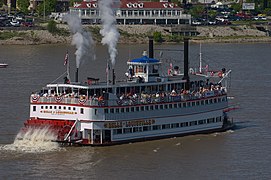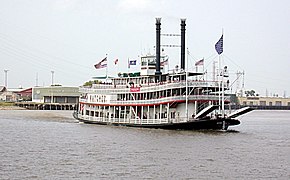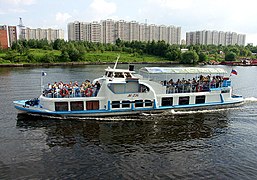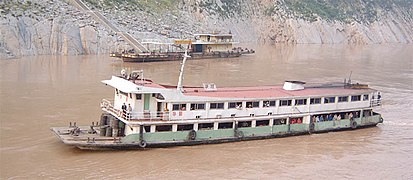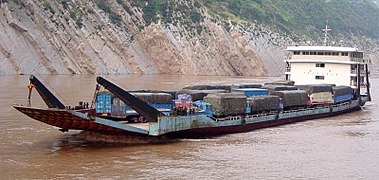Riverboat
This articleneeds additional citations forverification.(February 2024) |
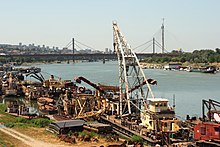

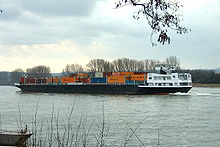
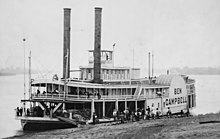
Ariverboatis awatercraftdesigned forinland navigationonlakes,rivers,and artificialwaterways.They are generally equipped and outfitted as work boats in one of the carrying trades, for freight or people transport, including luxury units constructed for entertainment enterprises, such as lake or harbourtour boats.As larger water craft, virtually all riverboats are especially designed and constructed, or alternatively, constructed with special-purpose features that optimize them as riverine or lake service craft, for instance,dredgers,survey boats, fisheries management craft,fireboatsand law enforcement patrol craft.
Design differences[edit]
Riverboats are usually less sturdy than ships built for the open seas, with limited navigational and rescue equipment, as they do not have to withstand the high winds or large waves characteristic to large lakes, seas or oceans. They can thus be built from light composite materials. They are limited in size by width and depth of the river as well as the height of bridges spanning the river. They can be designed with shallow drafts, as were the paddle wheel steamers on the Mississippi River that could operate in water under two metres deep.
While aferryis often used to cross a river, a riverboat is used to travel along the course of the river, while carrying passengers or cargo, or both, for revenue. (Vessels like 'riverboat casinos' are not considered here, as they are essentially stationary.)
The significance of riverboats is dependent on the number of navigable rivers andchannelsas well as the condition of theroadandrailnetwork. Generally speaking, riverboats provide slow but cheap transport especially suited forbulk cargoandcontainers.
History[edit]

As early as 20,000 BC people started fishing in rivers and lakes usingraftsanddugouts.Roman sources dated 50 BC mention extensive transportation of goods and people on the riverRhine.Upstream, boats were usually powered bysailsoroars.In the Middle Ages,towpathswere built along most waterways to useworking animalsor people to pull riverboats. In the 19th century,steamboatsbecame common.
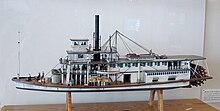
The mostfamous riverboatswere on the rivers of themidwesternand central southernUnited States,on theMississippi,OhioandMissouririvers in the early 19th century. Out west, riverboats were common transportation on theColorado,Columbia,andSacramentorivers. These American riverboats were designed to draw very little water, and in fact it was commonly said that they could "navigate on a heavy dew".[1]
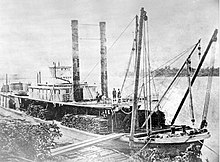
Australia has a history of riverboats. Australia's biggest river, theMurray,has an inland port calledEchuca.Many large riverboats were working on the Murray, but now a lower water level is stopping them. TheKalgan Riverin Western Australia has had two main riverboats, theSilver Star,1918 to 1935, would lower her funnel to get under the low bridge. Today, theKalgan Queenriverboat takes tourists up the river to taste the local wines. She lowers her roof to get under the same bridge.
It is these early steam-driven river craft that typically come to mind[dubious–discuss]when "steamboat"is mentioned, as these were powered by burning wood, with iron boilers drafted by a pair of tall smokestacks belching smoke and cinders, and twin double-acting pistons driving a large paddlewheel at the stern, churning foam. This type of propulsion was an advantage as a rear paddlewheel operates in an area clear of snags, is easily repaired, and is not likely to suffer damage in a grounding. By burning wood, the boat could consume fuel provided by woodcutters along the shore of the river. These early boats carried a brow (a short bridge) on the bow, so they could head in to an unimproved shore for transfer of cargo and passengers.
Modern riverboats are generallyscrew (propeller)-driven, with pairs ofdiesel enginesof several thousand horsepower.
The standard reference for the development of the steamboat isSteamboats on Western Rivers: An Economic and Technological HistorybyLouis C. Hunter(1949).[2]
Terrace, British Columbia,Canada, celebrates "Riverboat Days" each summer. TheSkeena Riverpasses through Terrace and played a crucial role during the age of thesteamboat.The first steam-powered vessel to enter the Skeena was theUnionin 1864. In 1866 theMumfordattempted to ascend the river but was only able to reach theKitsumkalum River.It was not until 1891 that the Hudson's Bay Company sternwheeler theCaledoniasuccessfully negotiated through theKitselas Canyonand reachedHazelton.A number of other steamers were built around the turn of the century, in part due to the growingfish industryand thegold rush.[3]
TheWT Preston,amuseum shipthat was once a specialised riverdredge,also called a "snagboat".
Modern riverboats[edit]
Luxury tourist transport[edit]
Some large riverboats are comparable in accommodation, food service, and entertainment to a modern oceaniccruise ship.Tourist boats provide a scenic and relaxing trip through the segment they operate in.
On the Yangtze River, typically employees have double duties: both as serving staff and as evening-costumed dancers.
- Tourist riverboats
-
A riverboat on theYangtze
-
A riverboat on theWillamette River,Oregon
-
TheDelta Kingis in use as a floating restaurant/hotel in Old Town Sacramento, California
-
TheDelta Queenis a sister boat to theDelta King.
Smaller luxury craft (without entertainment) operate on European waterways - both rivers and canals, with some providing bicycle and van side trips to smaller villages.
High-speed passenger transport[edit]

High-speed boats such as those shown here had a special advantage in some operations in the free-running Yangtze. In several locations within theThree Gorges,one-way travel was enforced through fastnarrows.While less maneuverable and deeper draft vessels were obliged to wait for clearance, these high-speed boats were free to zip past waiting traffic by running in the shallows.
Local and low-cost passenger transport[edit]
Smaller riverboats are used in urban and suburban areas for sightseeing and public transport. Sightseeing boats can be found in Amsterdam, Paris, and other touristic cities where historical monuments are located near water.
The concept of local waterborn public transport is known aswater taxiin English-speaking countries,vaporettoin Venice, water/river tramway informer Soviet Unionand Poland (although sightseeing boats can be called water tramways too). Local waterborne public transport is similar to ferry.
The transport craft shown below is used for short-distance carriage of passengers between villages and small cities along the Yangtze, while larger craft are used for low-cost carriage over longer distance, without the fancy food or shows seen on the tourist riverboats. In some cases, the traveller must provide their own food.
- Passenger Transport Ships
-
Sightseeing boat in Amsterdam
-
River tramwayMoskvitchin Moscow
-
Vaporettoin Venice
-
Low-cost transport in China
Goods transport[edit]
Multimodal[edit]
As the major rivers in China are mostly east-west, most rail and road transport are typically north-south. As roads along the rivers are inadequate for heavy truck transport and in some cases extremely dangerous,drive-on/drive-offramp barges are used to transport trucks. In many cases the trucks transported are new and are being delivered to customers or dealers. Perhaps unique to China, the new trucks observed traveling upstream were all blue, while the new trucks traveling downstream were all white.
Bulk cargo[edit]
Low-value goods are transported on rivers and canals worldwide, since slow-speed barge traffic offers the lowest possible cost per ton mile and the capital cost per ton carried is also quite low compared to other modes of transport.
- Cargo Ships
-
Cargo riverboat
-
Riverboat used for bulk cargo transport
-
SSInlanderon theSkeena RiveratKitselas Canyon,1911
See also[edit]
- Barge
- Chain boat
- Life on the Mississippi
- Ferryboat
- Fireboat
- Charles T. Hinde,a riverboat captain in the 1800s.
- Hydrofoil
- Keelboat
- List of steamboats on the Columbia River
- McKenzie River dory
- Murray-Darling steamboats
- Narrowboat
- P.A. Denny(ship)
- Paddle steamer
- River cruise
- Sampan
- Shitik
- Steamboat
- Steamboats of the Mississippi
- Steamboats of the Columbia River
- Steamboats of the upper Columbia and Kootenay Rivers
- Steamboats of the Willamette River
- Tourist sternwheelers of Oregon
- Towboat
- Tugboat
- Frederick Way Jr.
- Lewis and Clark's Keelboat
References[edit]
- ^"Boating on the Ohio".Machinery,Lester Gray French, ed. Industrial Press, vol. 6, July 1900, p. 334.
- ^ Hunter, Louis C.; Bryant, Lynwood (1949).Steamboats on Western Rivers: An economic and Technological History.
- ^Pioneer Legacy - Chronicles of the Lower Skeena River - Volume 1,Norma V. Bennett, 1997,ISBN0-9683026-0-2
Further reading[edit]
- Crump, Thomas,Abraham Lincoln's World: How Riverboats, Railroads, and Republicans Transformed America.(New York: Continuum, 2009) 272 pp.ISBN978-1-84725-057-5.
- Nolan, John Matthew.2,543 Days: A History of the Hotel at the Grand Rapids Dam on the Wabash River
- Lehman, Charles F. (2009).A riverman's lexicon: in Lehman's terms.Florissant, Mo.: J.R. Simpson & Associates.ISBN978-0-9841503-0-4.Nautical terminology specific to towboating and inland waterways.
- Twain, Mark (1883).Life on the Mississippi.Boston, J. R. Osgood.



